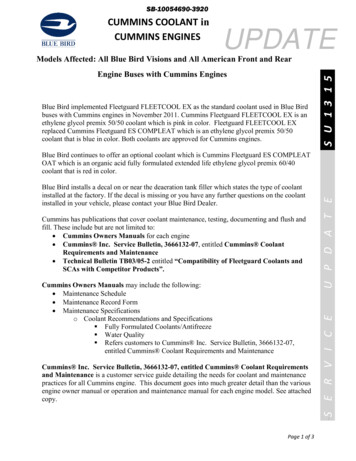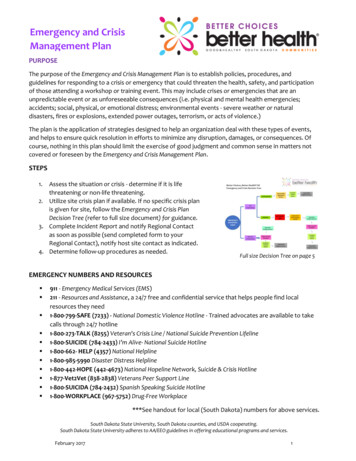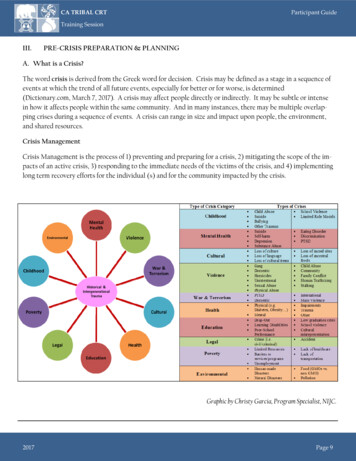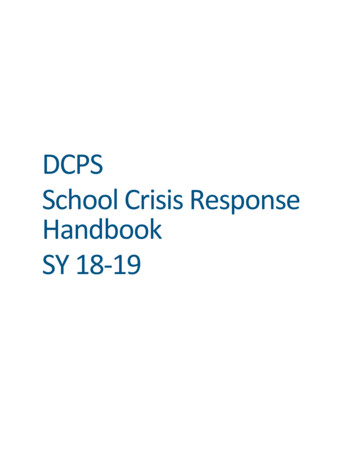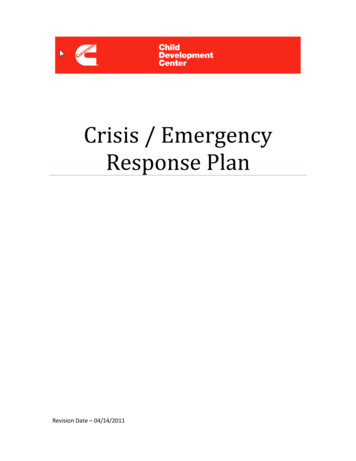
Transcription
Crisis / EmergencyResponse PlanRevision Date – 04/14/2011
CRISIS/ EMERGENCY RESPONSE PLANPURPOSEThis manual is designed to be distributed, discussed and simulated with faculty and administration inCummins Child Development Center, Columbus, Indiana with the support of appropriate Cummins Inc.office departments. The manual is intended as a preparedness plan to help the Child Care Center respondpromptly and effectively to potential crisis situations including, accidents, disasters, criminal activity,litigations, outside investigation and allegations. This plan is also meant to coordinate with the largercampus-wide crisis management plans developed by Cummins Inc. Corporate Offices.INTRODUCTIONThe Cummins Child Development Center could be subject to an emergency situation affecting the facilityor as part of a larger scale event. The Center Director and staff are responsible for the safety of children,and will coordinate actions and/or requirements with Cummins Emergency Response Team, communitypublic safety officials and parents/guardians.The impact of an emergency on children can have lasting effects on their well being. Caregivers andfamilies must manage the response to the emergency as well as helping children cope with their feelings,fear and needs during and after the emergency. Respecting the child’s feelings, and involving them wherepossible in recovery activities can reduce stress and anxiety.It is the goal of the Cummins Child Development Center to respond promptly and effectively to any eventthat may directly affect children, parents, employees, or Cummins Inc. It is our belief that emergencyplanning and preparedness must include awareness and clear procedures at all levels, from the CumminsChild Development Center, administration and Cummins Inc. to individual employees, parents, andchildren.The intent of this plan is to assist the staff in responding to emergency situations and provide information tofamily members concerning emergency planning. This plan contains emergency response information forthe following situations:NATURAL HAZARDS:Severe Weather- Snow and Ice Storms- Tornado or severe thunderstorms- Earthquake- FloodingTECHNOLOGICAL HAZARDS:Power OutageFireChemical SpillsBomb threat or threatening telephone callPERSONAL SAFETY:Medical EmergencyMissing ChildPotentially Violent Situations – (Hostage situation, disgruntled employees, unstable custody)The plan will also address protective actions such as:EvacuationShelter-in-PlaceSpecific directions for infants, toddlers, early pre-school, pre-school, pre-kindergarten andkindergarten in crisis situations2
TABLE OF CONTENTS1.0 GENERAL INFORMATION1.10 Facility Organization1.11 Emergency Notification1.12 Staff Call Down Telephone List2.0 EMERGENCY RESPONSE TEAM PROTOCOL3.0 NATURAL HAZARDS3.10 Severe Weather3.11 Snow and Ice Storms3.12 Tornado3.14 Earthquake3.15 Flooding3.16 TECHNOLOGICAL HAZARDS3.17 Power Outage3.18 Fire3.19 Chemical Spills3.20 Bomb Threat or Suspicious Article/Message3.21 PERSONAL SAFETY3.22 Medical Emergency3.23 Missing Child3.24 Unauthorized or Suspicious Person4.0 Protective Actions4.10 Evacuation4.11 Shelter in PlaceB. LIST OF FIGURES1. Facility floor plan with evacuation routes and shelter areas, fire alarms, fire suppressionequipment and extinguishers.C. LIST OF ATTACHMENTS5-1 Evacuation Checklist5-1A Evacuation Requirements Sheet5-1B Parent/Guardian Emergency Evacuation Plan Information5-2 Bomb Threat ChecklistAnnexure A – List of items to be maintained in the Emergency Backpack3
1.0 GENERAL INFORMATIONCummins Child Development Center:1. Is responsible for establishing a plan to effectively manage crisis/emergency situations at thecenter2. Will use methods and processes to protect the life, health, safety, and welfare of employees,parents and children3. Will seek prompt resolution to each and every crisis/emergency situation4. Will coordinate actions and decisions with those dictated by Center Emergency Response Team5. Will maintain and enforce program to fulfill all of the Center responsibilitiesThe objective of this crisis/emergency program is to develop effective employee work habits and attitudesduring an emergency or crisis. It is important that new employees understand emergency responseprocedures prior to being assigned a job. It is even more imperative that all employees remain alert andresponsible for awareness of potential emergency issues and the need to recommend changes in the eventthat problems are identified.1. New employees will be given an orientation that covers Cummins Child Development Center(CCDC) Crisis/Emergency Response Plan2. There will be two staff meetings a year where the agenda will be focused on crisis/emergencyresponse scenarios and reviewing crisis/emergency response procedures3. The CCDC administrative staff will hold a meeting once every other month wherecrisis/emergency response will be part of the agenda4. The CCDC administrative staff will coordinate with Cummins Inc. Corporate Offices to hold acrisis/emergency simulation at the Child Care Center twice each year besides standard fire,tornado and flood drill practices5. Employees, who take safety seriously, report potential danger or crises, request reviews ofconditions, etc. will be held in the highest regard by the Center6. Under no circumstance would an employee be reprimanded, demoted, fired, or discriminatedagainst for reporting emergency issues or potential safety/ crisis situationsEmployees who do not treat crisis/emergency response seriously, do not abide by Center policies andpractices, or operate in an unsafe manner, are subject to progressive counseling as outlined in the CumminsChild Development Center’s employee handbook.1.10 FACILITY ORGANIZATIONThe Cummins Child Development Center is located at 650 Pleasant Grove Columbus, IN 47201 which ison the corner of 7th and Central Ave. The Center capacity is 228. The amount of staff is determined onour enrollment status and with the state regulation ratios compliance. The Center is opened from 6:30am to6:00pm, and follows Cummins Inc. schedule (Mon-Fri). The Management team consists of CenterDirector, Assistant Director, Office Manager, and Program Coordinator.ClassroomInfant OneInfant TwoInfant ThreeTransitioning Infant FourToddler OneToddler TwoToddler ThreeTransitioning Toddler FourEarly Preschool OneEarly Preschool TwoEarly Preschool ThreeTransitioning Early Preschool FourPreschool OnePreschool TwoPre-Kindergarten OnePre-Kindergarten TwoKindergartenEducational Enhancement RoomRatioMaximum number of 101:101:101:148 Children8 Children8 Children8 Children10 Children10 Children10 Children10 Children14 Children14 Children14 Children14 Children20 Children20 Children20 Children20 Children14 Children4
The safety features consist of first aid kits in every classroom and in every room of the building, plus twolarge emergency back packs. List of items maintained in the emergency back packs are provided inAnnexure A of this plan. CCDC also has security pass code entry and four emergency shelter rooms. Eachstaff members are trained in First Aid, CPR, and blood borne pathogens annually.Cummins Inc.Cummins LiaisonBright HorizonsCenter DirectorCummins ChildDevelopment CenterParentsOther CenterFaculty MembersChildrenOther CenterFaculty MembersOfficeManagerAssistantDirectorCCDC TeachersCCDC TeachersCenter Support Services Program Development& Resources Education & Training Human Resources Facility Support & RiskManagementRegional ManagerBright HorizonsFamily SolutionsDivision V.P.Bright HorizonsFamily SolutionsBright HorizonsFamily SolutionsAdvisory BoardOther Client Team Membersand Other LocalOperational Support5Center Support Services Home OfficeAdministration Marketing &Communications Financial Services Client Relations &Partnership ServicesOtherBright HorizonsFamily Centers
Figure 1 – Building Plan and Evacuation routes6
1.11 EMERGENCY NOTIFICATIONAny EMERGENCY MEDICAL EMERGENCY. .POLICE.FIRE.RESCUE.HOSPITAL.North side PediatricsPOISON CONTROL.Child Protected ServicesAnimal ControlCall 911911911, 812.376.2600911, 812.376.2679911, 0.800.5556812.376.2505COLUMBUS (EMERGENCY MANAGEMENT AGENCY)UTILITIES –ELECTRIC.Electric Trouble/OutageDuke Energy800.521.2232800.343.3525STAFF CALL DOWN .SEE 1.12NEWS/ MEDIARADIO STATIONS .QMIX 107.3 FMNEWSPAPERS The HOLOMEW CONSOLIDATED SCHOOL CORPDepot OfficeTransportation Manager812 376 4246812 343 1434KEY CUMMINS CONTACT AND LINES OF COMMUNICATIONColumbus Engine Plant Gate 1 Security (primary emergency contact)7-4357/ 812.377.4357Cummins Tech Center Security (standby emergency contact)7 – 7400/ 812.377.7400CCDC Emergency Response Team Leader – Victoria Baker812.378.5833 ext 233812.344.5966Bright Horizon Contact (1) – Mindy PohlOffice: 812-615-0180Cell : 812-615-0180Bright Horizon Contact (2) – Patti Eickhoff DVPOffice: 330-873-9485Cell: 330-873-9485Office: 812-377-0340Cell: 812-344-8521Office: 812-377-6266Cell: 812-350-3470Office: 812-377-4351Cell: 812-343-9754Columbus Engine Plant ERT Contact (1) – Ryan GenthColumbus Engine Plant ERT Contact (2) – Tommy RobinsonCummins Tech Center ERT Contact (1) – Mark Mandel7
1.12 STAFF CALLDOWN/TELEPHONE ROSTER (Name, title and phone no)The CCDC staff shall maintain an updated call down roster as a separate document inside the facility. Thiswill be maintained as an internal document for official CCDC use only.8
2.0 EMERGENCY RESPONSE TEAM PROTOCOLThere are 7 essential jobs during the center evacuation:1. Emergency Response Team (ERT) Leader2. Primary Manager3. First Aid Office4. Communications5. Play space operations6. Parent pick-up point7. External ERT SupportBefore an emergency, a person and alternate should be assigned to each of these jobs and scenarios shouldhave them act out these roles.1.ERT Leader – Victoria BakerAlternate: Cindy Reed1. The ERT Leader, in consultation with the Emergency Response Team, and others if needed,shall establish the response strategy and shall assume control of the center until external helparrives2. Carry out initial assessment of the scene and determines the appropriate course of action forteam members3. Establishes and maintain communications between the center and external support facilities/agencies4. Request resources to augment the center’s response capabilities5. Provide all required information and appropriate directions to the external ERT support teamupon arrival6. Initiate Emergency Response actions and coordinate with the ERTs (internal and external)7. Determine the safest location for continued operations until children can be picked up and thesafest path for all staff and children to get there8. Initiate the notification process2.Primary Manager – Cindy ReedAlternate: Becky Bunch1. Make sure all children are accounted for2. Coordinate with the ERT Leader to determine the safest location for continued operationsuntil children can be picked up and the safest path for all staff and children to get there3. Activate the first aid assignment if needed and assess the number and severity of injuries4. Activate the play space assignment5. Activate the parent pick-up assignment and determine the best location away from the first aidstation6. Activate the communications assignment and provide specific phrases for the caller andinformation regarding the emergency and about the parent pick-up point – when possible, bethe one to make contact with those families whose children are injured as a result of the event7. Determine if there are other assignments that need attention based on your circumstances (i.e.sanitation/bathroom, transportation, search and rescue) and take action to assign8. Check in regularly with each assignment (every 15 minutes) to problem solve and issues9. Stay alert, unencumbered for any length of time and calm.3.First Aid Assignment – Becky BunchAlternate: Kathy Yeager1. Quick assessment of number and severity of injuries – report to Primary Manager2. Determine how many adult helpers first aid will need and deputize people to assist3. Collect emergency first aid supplies and set-up first aid station using blankets and tarps –seek to obscure the view of the first aid station from other children and parents picking up4. Keep an updated record for all minor and major injuries to report to Primary Manager,including those transported of-site by emergency medical services5. Report back to Primary Manager with updates, needs, and problems during his/her rounds4.Communication Assignment – Becky SmithAlternate: Janice Vonsh1. Check with Primary Manager about exact info to give to families when calling (emphasisshould be placed on the child’s condition and the pick-up location)9
2.3.4.Locate nearest phone and collect the emergency binder from the Primary Manger withfamily phone numbersDiscuss w/Primary Manager exact wording to offer families whose children have beeninjured in some way by the eventReport back to Primary Manager with updates, needs, and problems during his/her rounds5.Play Space Assignment – Becky SmithAlternate: Kathy Yeager1. Determine where to set up a different group of children (see sketch if using alternate site)2. Use blankets, table, and chairs to define play spaces for children – define an area for food3. Determine the nearest and safest toilet area and arrange for supervision4. Report back to Primary Manager with updates, needs, and problems during his/her rounds6.Parent Pick-Up Assignment – Kathy YeagerAlternate: Janice Vonsh1. Establish an area away from the Primary play area and first aid areas to control parentaccess2. Collect all the sign-in sheets to monitor parent pick-ups also maintain a running log asback up3. Deputize a staff member to serve as a gopher collecting children whose parents arrive andbringing them to the pick-up point4. Do your best to calm parents before they collect their child(ren)5. Report back to Primary Manager with updates, needs and problems during his/her rounds7.External ERT Support – Ryan Genth (CEP)Mark Mandel (CTC)Alternate: Tommy Robinson(The External Support team (CEP (primary support) & CTC (backup)) shall minimum consist oftwo Certified First Aiders, two Certified Fire Fighters and two support team members)1.2.3.4.5.Report to the Center Emergency Response Team Leader upon arrival at site and gather allrequired information and seek directions to determine the right supportIf situation demands, take control of the situation and act as the Primary EmergencyResponders (e.g., in the event of fire, major disaster etc)Assist the Center Emergency Response Team to efficiently set up the arrangements asdescribed above (first aid, communication, play space, parent pick up etc)Assist in the evacuation activities (if evacuation is indicated) to setup a secured boundaryfor safe evacuation, crowd management/ control, traffic management, and to setup thereunion site for the parents to pick their children at the off-site evacuation siteReport back to Center ERT Leader with updates and support him/ her to take the rightdecisions to manage the situation3.0 NATURAL HAZARDSNatural hazard emergencies relate to conditions caused by weather, weather related effects, and geologicalevents such as earthquakes.3.10 SEVERE WEATHERSevere weather may be predicted over several days in advance in the case of hurricanes and winter stormsor within a few hours or less for tornado and other wind, rain, or ice storms. Listening to weather forecastsand storm watch or warnings is critical to being prepared. The National Weather Service issues stormwatch and warnings through commercial television, radio, cable (Weather Channel) and NOAA weatheralert radios.In general:1. Severe Weather Watch means that conditions are present that could cause a weather emergency inthe areas mentioned; and,2. Severe Weather Warning means that severe weather has been observed or is expected soon andthat precautions should be taken in the affected areas.10
Cummins Child Care Center have established the following sources of communication to receive severeweather alerts (watch and warnings)1. Columbus Engine Plant Gate #1 Security – all emergencies2. Columbus Police Department – Weather Alerts – (is equipped to provide exact information onwhere in the county is the most threatening weather. Ex: N, S, E, W)3. QMIX 107.3 FM radio – NOAA weather alerts4. Columbus Alerts Email service – NOAA weather alerts for Columbus City5. NOAA Website - http://www.crh.noaa.gov/ind6. Creek Levels updates - http://water.weather.gov7. Columbus City Alert – Tornado/ Thunderstorm/ Hurricane alarms8. Cummins Technical Center Security – Flood emergency early warningSevere Weather Take Cover CriteriaThe Severe Weather Take Cover announcement for the center campus sounds like this: “The Center iscurrently experiencing severe weather. Please proceed immediately to the designated shelter rooms closestto your location”If the Governor/ Mayor or County Commissioners of Columbus declare a State of Emergency forBartholomew County, the center will not open until the State of Emergency has been lifted. In the eventsuch conditions arise while the center is closed, (example: during the night) the parents shall be informedvia email, telephone or text messaging and over QMIX 107.3 FM radio broadcast that the center is closed.If QMIX 107.3 FM does not make an announcement and/ or a phone call or text message is not receivedindicating that the center is closed, it would be assumed that the center is open for business.3.11 SNOW AND ICE STORMSSevere snow and ice storms can result in the shutdown of facilities, closed roads, and damage to powerlines and structures.1.2.3.4.Monitor winter storm watch, warnings, blizzard warning or travel advisoriesCenter Director / ERT Leader may consider pre-storm closing (night before) or early closingdepending on conditionsArrange for snow and ice removal as well as possible debris removal such as fallen trees andutility linesCheck status of battery powered radios, flash lights, and back-up lighting, power, and heatIf the National Weather Service issues a winter storm watch for Bartholomew County, the ERT Leadershall respond with a heightened sense of awareness, by watching for changing conditions that may precededangerous weather. The ERT Leader shall inform all the teachers and staff about the situation. Teachersand staff shall bring all the students insideIf the National Weather Service issues a winter storm warning the ERT Leader shall coordinate to informparents via text messaging or other methods described above to make arrangements to have their childrenpicked up early.A severe snow or ice storm usually is forecast and not a surprise. In the most unlikely situations, if thesnow or ice storm is expected soon or experienced while the center is in operation, the ERT Leader shallinitiate the following response actions –1.2.3.As severe snow or ice storms typically do not present danger to the occupants of the center, theERT leader shall primarily focus on maintaining an awareness of changing external environmentand road conditions and maintain a heightened awareness of those conditions through the variousinformation sources listed above.If the power goes out, refer to the Power Outage Section (3.17) of the planERT Leader or a designee shall continue monitoring radio bulletins and weather forecasts as oftenas possible11
4.5.6.If the phones go out, ERT Leaders shall check his/ her cellular phone and walkie-talkie to see if itis operational. Limit calls to emergency use onlyERT Leader shall maintain constant communication with the External ERT support contacts overthe walkie-talkie or phone for expert advice/ consultationShould early closure of the center be indicated, the ERT Leader shall go out and make sure theevacuation route is safe.3.12 TORNADO OR SEVERE THUNDERSTORMWeather fronts that can produce tornadoes may also generate severe rain, wind and hail that can causeserious damage. A Tornado Watch means that a tornado is likely over a large area and a Tornado Warningmeans that a Tornado has been sighted, or is indicated on weather radar in a specific area.a.b.c.Tornado or Severe Thunderstorm Watch - If the National Weather Service issues aTornado or Severe Thunderstorm Watch for Bartholomew County, the ERT Leader shallrespond with a heightened sense of awareness, by watching for changing conditions thatmay precede dangerous weather. The ERT Leader shall inform all the teachers and staffabout the situation. Teachers and staff shall bring all the students inside and kept awayfrom windows and in areas of the center that are farthest away from large trees and powerpoles. The ERT leader may initiate the process to move all students and staff to theshelter areas. The ERT Leader will maintain vigil near the front door of the center.Tornado or Severe Thunderstorm Warning - If the National Weather Service issues aTornado or Severe Thunderstorm warning, the ERT Leader will initiate the process tomove all students and staff to the shelter area. The ERT leader will locate in theappropriate shelter area as well. During Tornado Warning situations specifically, theparents will not be able to pick up their child(ren) until the All Clear announcement ismade by the National Weather Service and acknowledged by the ERT Leader.Parents will be notified of any center status changes or situations as a result of theseconditions via text messaging or other methods described above.A Tornado or a Severe Thunderstorm usually is forecast and not a surprise. In the most unlikely situations,if the Tornado or Severe Thunderstorm is expected soon or experienced while the center is in operation, theERT Leader shall initiate the following response actions –1. Teachers and staff shall ensure that all students have been moved inside the center.2. May activate the Severe Weather Take Cover announcement. This would initiate the EmergencyResponse Team’s actions as explained in Sec 2.0.3. Teachers and Staff shall direct the students to the designated shelter rooms in an orderly manner.4. During a tornado watch situation, The ERT Leader shall remain available at the front door of thecenter to escort any parents who wish to collect their children during this situation. The parentwill be escorted to the appropriate shelter and returned to the front door with their child/children.Parents understand that upon exiting the center, the safety of the child resides with them. Duringthe Tornado Warning situation, the center will go into lock down mode and parents will not beable to collect their children.5. If the power goes out, refer to the Power Outage Section (3.17) of the plan6. ERT Leader or a designee shall continue monitoring radio bulletins and weather forecasts as oftenas possible7. If the phones go out, ERT Leaders shall check his/ her cellular phone and walkie-talkie to see if itis operational. Limit calls to emergency use only8. ERT Leader shall maintain constant communication with the External ERT support contacts overthe walkie-talkie or phone for expert advice/ consultation9. Post any tornado occurrence, should evacuation of the center be indicated, ERT Leader shall goout and make sure the evacuation route and meeting point are safe10. ERT Leader shall request the External ERT support for their support during evacuation11. Refer to the Evacuation Section (4.10) of the plan12. Upon cancellation of any watches and/or warnings post the above described situations, the ERTLeader will decide at which point the center shall resume normal operations. Parents will benotified of center status and situation through text messaging or other methods described above.12
3.14 EARTHQUAKEAn earthquake is least predictable. Damage to structures, and utilities and injury to people from fallingdebris are mostly expected as a result of earthquakes. In an earthquake, most injuries and deaths are causedby loose objects in and on buildings. During the shaking, cabinets and bookcases topple, objects fall out ofcabinets, and hanging or large plants fall. Door frames and window jams may be bent when walls move.Doors may slam or jam shut, and window glass can shatter, sending broken glass into the room. Lightfixtures, sprinkler heads, and other ceiling components may pop out and fall. Objects mounted on the walls(such as clocks, maps, and art work) may shake loose and fly across the room. The electricity may go out,and the sprinkler systems or fire alarms may turn on.1.Planning:Assess the facility to reduce the potential for shelving, fixtures, or heavy equipment to causeinjury if shifted suddenly. Ensure that building and safety codes are followed during constructionor renovations. Know where and how to shut off electricity, gas, and water service. Locate thesafest locations in each room away from windows and potential falling objects.2.Response:a) A designated safe spot outside is the safest place to move in case of an earthquake.Note: This spot should always be away from the building, trees, playground structures, fences,utility wires, or anything else that might fall on you. Ensure that all children and staff know whereto go if they need to leave the building in an emergency.The designated safe spot outside is identified as the “Emergency Assembly Point” for the center and islocated at the South side of the facility in the athletic field. The evacuation routes and the Assembly pointare clearly marked in the facility plan (ref fig 1).b) The Earthquake Evacuation announcement for the center campus sounds like this:1. Evacuation to outside - “The Campus is currently experiencing Earthquake. Pleaseproceed immediately to the Emergency Assembly Point”2. Stay inside - “The Campus is currently experiencing Earthquake. Please drop to theground, take cover under a firm support and hold on until the shaking stops. Do not moveand wait for further announcement”c) The ERT Leader shall initiate the following response actions 1. Activate the Evacuation announcement. The announcement shall initiate the EmergencyResponse Team’s actions as explained in Sec 2.0.Note, evacuation to outside shall be initiated only if it is not shaking and the ERT Leadershall decide to do so after consulting with other Emergency responders.d) Once in the open, the following response actions shall be initiated in addition to the responseteam responsibilities explained in Section 2.0 of the plan 1.2.Kneel or sit on the ground and cover your head and face with your handsStay there until All Clear announcement is madee) It is not recommended to evacuate to outside during the shaking. Falling bricks and debris justoutside of the building could be a major concern in such situations.If inside, during an earthquake, the following response actions shall be initiated –Upon hearing the announcement (to remain inside) or at the first sign of shaking i. Drop to the groundii. Take Cover by getting under a sturdy table or other piece of furniture.iii. Hold on until the shaking stops.13
This is further explained below i. Kneel down under a desk, table, or bench. If there aren’t enough sturdy pieces offurniture to get under, kneel next to an interior walls but away from windows, overheadlight fixtures, and tall pieces of furniture that might fall over.ii. Stay under cover until the shaking stops (at least one minute). Face away fromwindows, and bend your head close to your knees.iii. Hold on to the table leg or desk (a few inches above the ground to avoid pinchingfingers). Cover your eyes with your other hand. If your “shelter” moves, move with it. Ifyou don’t have a “shelter” to hang on to, clasp your hands on the back of your neck toprotect your face.g) ERT Leader shall maintain constant communication with the External ERT support contactsover the walkie-talkie or phone for expert advice/ consultationf) Should evacuation of the center be indicated, ERT Leader shall go out and make sure theevacuation route and meeting point are safeh) ERT Leader shall request the External ERT support for their support during evacuationi) Refer to the Evacuation Section (4.10) of the plan3.15 FLOODINGFlooding may result from heavy precipitation and build over several days or occur rapidly in the form offlash floods. Heavy rainfall as a result of Hurricanes, strong persistent thunderstorms etc., may also produceflooding.A Flood Watch means that a Flood is likely over a large area, but the occurrence is neither certain norimminent, A Flood Warning means that a Flood is indicated by monitoring stations in a specific area andmost likely to happen in less than 48 hours.A flash flood watch means that the potential exists for heavy rains to create flash flooding in the next 6 to24 hours and a flash flood warning means that Flash Flood conditions are occurring or are expected tooccur in the next 6 hours.Cummins Child Care Center have established the following sources of communication to receive earlyflood/ flash flood warning 1. Columbus Engine Plant – Gate #1 security - level scale on 7th St Bridge2. Cummins Technical Center Security – on-site monitoring on the state street bridge3. CCDC on-site creek level monitoring - level scale on 7th St Bridge4. Columbus
Cummins Child Development Center, Columbus, Indiana with the support of appropriate Cummins Inc. office departments. The manual is intended as a preparedness plan to help the Child Center respond Care promptly and effectively to potential crisis situations including, accidents, disasters, criminal activity,
